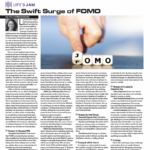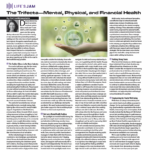
“TikTok made me do it,” a friend recently confessed about her impulse buy—a weighted hula hoop. After repeatedly seeing the product in videos and ads, she finally succumbed. Does this sound familiar? Have you ever experienced the thrill of clicking “Buy Now,” eagerly awaiting an item’s arrival, only to find it forgotten in a corner months later, barely used?
I totally get it—impulse buys can sometimes turn out to be fantastic. If that hula hoop becomes part of a daily routine that brings joy and results, then it’s money well spent. However, money is a finite resource, and we constantly face decisions about how to best allocate it. While attending Music Biz in Nashville a couple of weeks ago, I found myself in a conversation about debt payback strategies that revealed widespread misconceptions. It’s clear that there’s a need to demystify some of the key concepts which we’ll explore here.
Why Is Debt at an All-Time High, Especially in the Music Industry?
Debt levels are hitting record highs, and the reasons are complex. For many, particularly in the music industry where incomes can vary wildly, the allure of borrowing comes as a quick fix to financial gaps. When you’re not sure where your next paycheck is coming from, credit cards or loans can feel like a lifeline, especially for those still recovering from the pandemic’s severe impact on their finances. The cancellation of tours and gigs not only halted income but also depleted savings, leaving many to rely more heavily on credit to bridge their financial gaps.
The economy plays its part too—recent increases in interest rates have made loans and credit more expensive, yet they might still seem necessary when essentials like housing and healthcare continue to become more expensive at a rate that often outstrips what people earn. It’s a tough situation, especially when your income depends on the next gig or tour.
And let’s talk about our buying habits. Today’s marketing is relentless, with ads popping up everywhere, pushing the latest must-have gear or tech, which can be especially tempting in tech-heavy industries like music. The ease of digital payments means you can spend money with just a tap, often without feeling the immediate impact on your wallet.
The problem is compounded by a lack of financial education. Many of us aren’t taught how to manage our finances or understand the real cost of debt—like how interest accumulates and turns a small loan into a mountain of debt. Without these skills, it’s easy to fall into a borrowing cycle that’s hard to escape.
Cultural pressures to “keep up” can exacerbate financial difficulties, compelling us to adopt lifestyle and spending habits that exceed our means. For musicians and industry professionals, this pressure is not merely about maintaining appearances; it’s often considered an integral part of the job.
Tackling Debt
So, how do we get a handle on our debt and feel like the odds aren’t stacked against us? First, it’s crucial to understand what led us into debt—was it a period of hardship, a decrease in income, habitual overspending, or all of the above? Establishing new financial habits is essential because once we clear our debt, we don’t want to slide back into old patterns.
DIY Debt Management: There are two popular strategies for tackling debt: the Snowball and Avalanche Methods. The Snowball Method involves paying off the debt with the smallest balance first, while the Avalanche Method targets the debt with the highest interest rate. Using the Snowball Method, you would make minimum payments on all your cards and direct any extra cash toward the card with the smallest balance. By focusing on paying off this card first, you quickly eliminate one obligation, providing a motivational boost. While the emotional uplift from clearing the debt is significant, this method might result in paying more interest overall compared to other strategies.
In contrast, the Avalanche Method involves prioritizing the card with the highest interest rate first. Although it may take longer to pay off the first card using this method, you’ll ultimately save more in interest payments. This approach is financially efficient because you tackle the most expensive debt first.
How Both Methods Accelerate Debt Repayment: Once you’ve paid off your first target card, you redirect what you were paying on that card to the next one on your priority list. This “snowballing” or “avalanche” effect increases the amount of money you can apply to your remaining debt. By the time you reach your last card, you’re applying a substantial sum towards it each month, significantly speeding up your debt elimination.
A Balanced Approach: While aggressively paying back your debt might feel like a huge win, it’s also crucial to build your emergency savings. If your next emergency ends up on your credit card, you could find yourself back at square one. If this means paying back your debt a little slower to maintain a financial cushion, it may well be worth it. This balanced approach helps ensure you’re prepared for unexpected expenses without derailing your financial progress.
[Tip: PowerPay.org and the Vertex42 debt reduction spreadsheet are my go-to tools. Before you start, gather all the necessary information: your credit card balances, minimum payments due, due dates, and interest rates. Pick a method and stick with it to see the best results.]
Negotiating Lower Interest Rates: Once you have a handle on the total amount you owe, you can try to negotiate a lower interest rate with your lender. This can be a good first step for some and is relatively straightforward. Make sure you’re ready with all your account info and a solid track record of on-time payments. It also helps to know what competing lenders are offering, so you can make a strong case. Give your lender a call, aiming to speak with someone in customer retention, as they often have the power to adjust your rates. Present your case by highlighting your loyalty, good payment history, and better rates available elsewhere. Remain friendly yet persistent and be open to counteroffers that still meet your financial goals. Once an agreement is reached, make sure you get it in writing and monitor your account to verify the new rate is applied correctly. [Tip: Need a script for talking with your lender? Shoot me a note, and I’ll send you mine!]
Exploring Additional Strategies
When you’re feeling the pinch of financial stress, it can be tempting to jump to the first solution that seems to offer relief. You might have seen commercials promoting debt relief or heard from friends about offers that seem too good to refuse. However, it’s critical to approach these solutions with caution. Always read the fine print and fully understand the terms you’re agreeing to. While options like a 0% interest rate offer a temporary reprieve, they often just postpone the problem—sometimes at a higher cost later due to fees or increased rates after the promotional period ends.
Debt Consolidation Loans: This is a common way to consolidate multiple debts into one. Many lenders offer debt consolidation loans, often advertised with a low “teaser” rate to entice you to apply. Be cautious—these rates don’t always last for the entire loan period, and you might end up paying more interest over time by moving your debt. The lower monthly payment can be deceiving because the loan term is extended, leading to higher total costs. [Tip: Before signing up, make sure to calculate the total fees and costs over the duration of the loan.]
0% Balance Transfer Cards: You can transfer high-interest debt (for some cards, this must be existing credit card debt) to a new card with no interest for a promotional period, typically 6 to 18 months. This stops your debt from growing due to interest, combines your debts into one easy payment, and can improve your credit score by reducing your credit utilization ratio. [Tip: Credit utilization is the percentage of your credit limit you’re using. Aim to keep it below 30%, or below 10% to boost your score.]
However, watch out for pitfalls like balance transfer fees (3-5% of the amount) and the need to pay off the balance before the promotional period ends to avoid high-interest rates. These cards usually require a good to excellent credit score. Also, avoid making new purchases on your 0% card, as payments typically go to the 0% balance first, leaving new purchases to accrue interest at a higher rate, potentially increasing your debt unexpectedly.
Home equity loan: You could consider a home equity loan or line of credit for debt consolidation if you have sufficient equity, but beware of the costs and risks, including the potential loss of your home if you default.
Non-profit Credit Counseling: These organizations assist you in navigating your debt, budgeting your payments, and arranging agreements with lenders. When you enroll in a Debt Management Plan (DMP) with a non-profit credit counselor, your monthly payments may be lower, as the counselor can often negotiate reduced interest rates and waived fees. However, they do not negotiate a reduction in the principal amounts you owe.
While participating in a DMP, you might be required to close your credit card accounts, which can lead to a temporary drop in your credit score. However, consistently making on-time payments through the DMP can eventually improve your credit score over time. [Tip: Don’t know where to start? Check out the National Foundation for Credit Counseling or The Financial Counseling Association of America.]
Debt Settlement: Debt settlement (or relief) companies are for-profit and usually charge hefty fees for their services. They try to negotiate with your lenders to settle your debts for less than what you owe, but there are major caveats to consider.
First, some lenders won’t negotiate with these companies. Second, these companies often advise you to stop paying your bills, which can tank your credit score and lead to late fees, interest, and potential lawsuits. If they can’t settle all your debts, fees on unsettled debts can negate any savings. One of my clients wished she had negotiated her credit cards herself after her credit score plummeted following the company’s advice. Lastly, the part of your settlement that is forgiven might be taxable. [Tip: Debt settlement can be a risky move with potential long-term consequences. It’s often worth looking into other options and getting professional financial advice before deciding on this route.]
You can reach Rachael Bronstein at rachael@lifesjam.com


